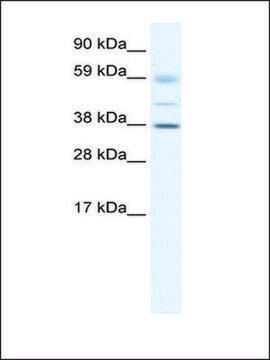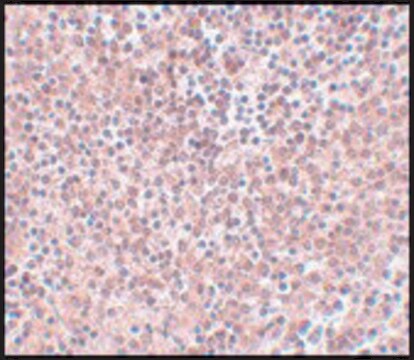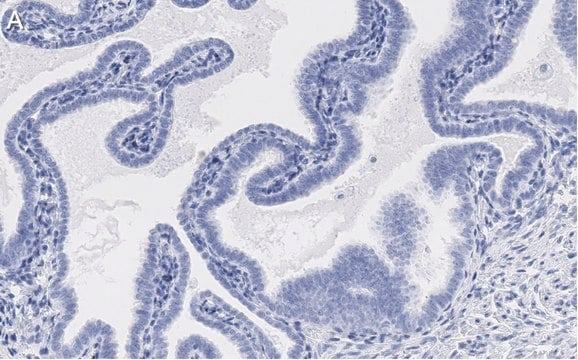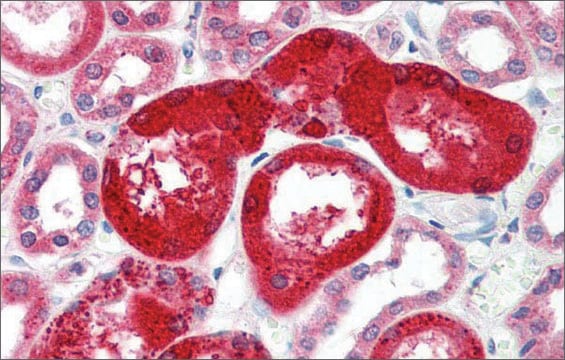General description
Transcription factor SOX-17 (UniProt: Q61473; also known as SOX-17) is encoded by the Sox-17 gene (Gene ID: 20671) in murine species. Sox17 protein is a member of the SOX (SRY-related HMG-box) family of transcription factors involved in the regulation of embryonic development and in the determination of the cell fate. It binds to the sequences 5′-AACAAT-3 or 5′-AACAAAG-3′ and modulates transcriptional regulation via WNT3A. Sox17 is reported to act upstream of the Notch system and downstream of the canonical Wnt system and acts as a link between the canonical Wnt and Notch signaling systems. It is involved in the regulation of the formation of cells that go on to develop into endodermal tissues like pancreatic and liver cells. SOX17 is the key regulator of human primordial germ cells (hPGSc) fate and is considered as one of the earliest markers. It is also shown to be the transcription factor for the regulation of oligodendrocyte progenitor cells, maintenance of fetal hematopoeitic stem cells, and in the mediation of cardiac muscle cell formation. SOX17 is selectively expressed in arterial endothelial cells at the early stages of embryonic development and maintains the same distribution postnatally and in the adult. Inactivation of SOX17 in endothelial cells in mouse embryo leads to a lack of arterial differentiation and vascular remodeling, which that results in embryo death in utero. (Ref.: Corada, M., et al. (2013). Nat. Communications 4, 2609; Niakan, KK et al. (2010). Gene Dev. 24(3): 312-326).
Specificity
This polyclonal antibody detects Sox17 in human, mouse, and rat. It targets an epitope within 17 amino acids from the N-terminal region.
Immunogen
KLH-conjugated linear peptide corresponding to 17 amino acids from the N-terminal region of murine Sox17.
Application
Anti-SOX17, Cat. No. 09-038-I, is a highly specific rabbit polyclonal antibody that targets Transcription factor SOX-17 and has been tested in Immunohistochemistry (Paraffin), Immunofluorescence, and Western Blotting.
Anti-SOX17, Cat. No. 09-038-I-25UG, is a highly specific rabbit polyclonal antibody, that targets Transcription factor SOX-17 and has been tested in Western Blotting and Immunofluorescence and Immunohistochemistry (Paraffin).
Research Category
Neuroscience
Western Blotting Analysis: 2 µg/mL from a representative lot detected SOX17 in 10 µg of human spinal cord tissue lysate.
Immunofluorescence Analysis: A 1:150-300 dilution from a representative lot detected SOX17 in human testis and rat colon tissues.
Immunohistochemistry Analysis: A 1:50-250 dilution from a representative lot detected SOX17 in human prostate, mouse stomach, and rat uterus tissues.
Western Blotting Analysis: 2 µg/mL from a representative lot detected SOX17 in 10 µg of human spinal cord tissue lysate.
Immunofluorescence Analysis: A 1:150-300 dilution from a representative lot detected SOX17 in human testis and rat colon tissues.
Immunohistochemistry Analysis: A 1:50-250 dilution from a representative lot detected SOX17 in human prostate, mouse stomach, and rat uterus tissues.
Quality
Evaluated by Western Blotting in H9 human stem cells.
Western Blotting Analysis: 2 µg/mL of this antibody detected SOX17 in 10 µg of H9 human stem cells lysate.
Target description
~40 kDa observed; 44.65 kDa calculated. Uncharacterized bands may be observed in some lysate(s).
Physical form
Affinity Purified
Purified rabbit polyclonal antibody in buffer containing 0.1 M Tris-Glycine (pH 7.4), 150 mM NaCl with 0.05% sodium azide.
Purified rabbit polyclonal antibody in buffer containing 0.1 M Tris-Glycine (pH 7.4), 150 mM NaCl with 0.05% sodium azide.
Storage and Stability
Stable for 1 year at 2-8°C from date of receipt.
Stable for 1 year at 2-8°C from date of receipt.
Other Notes
Concentration: Please refer to lot specific datasheet.
Disclaimer
Unless otherwise stated in our catalog or other company documentation accompanying the product(s), our products are intended for research use only and are not to be used for any other purpose, which includes but is not limited to, unauthorized commercial uses, in vitro diagnostic uses, ex vivo or in vivo therapeutic uses or any type of consumption or application to humans or animals.









